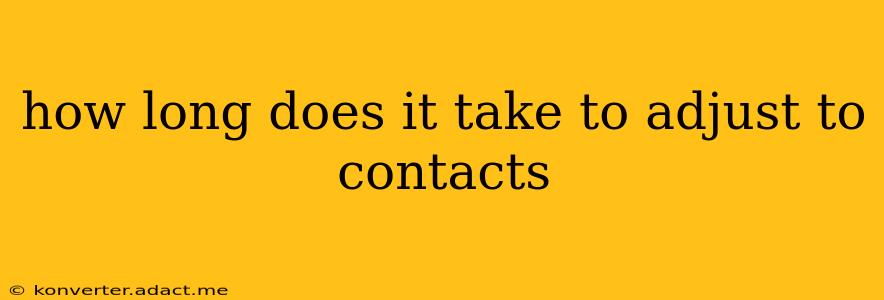Adjusting to contact lenses is a journey, not a race. The time it takes to feel completely comfortable varies greatly from person to person, influenced by factors like lens type, individual eye health, and how diligently you follow your eye doctor's instructions. While some people adapt within a day or two, others may require several weeks or even longer. Let's delve deeper into this common question and explore the factors involved.
What Factors Influence Contact Lens Adjustment Time?
Several key factors influence how quickly you acclimate to wearing contact lenses:
-
Type of Contact Lenses: Soft lenses generally require a shorter adjustment period than rigid gas permeable (RGP) lenses. Soft lenses are more flexible and conform more easily to the eye's shape. RGP lenses, while offering sharper vision, require a longer adaptation period as the eye needs to adjust to a firmer, less flexible lens. Multifocal and toric lenses (for astigmatism) may also take longer to get used to than standard spherical lenses.
-
Individual Eye Sensitivity: Some individuals naturally have more sensitive eyes than others. Those with dry eyes, allergies, or other pre-existing eye conditions may experience a longer adjustment period and possibly more discomfort during the adaptation process.
-
Proper Fitting and Handling: A precise lens fit is crucial. If the lenses are poorly fitted, they can cause discomfort and prolong the adjustment time. Similarly, incorrect handling techniques can lead to irritation and extended adjustment periods. Following your eye doctor's instructions meticulously is essential.
-
Consistent Wear: Gradual adaptation is key. Your eye doctor will likely recommend a wearing schedule that increases the duration of wear progressively. Jumping straight into full-day wear can significantly prolong the adjustment period and potentially lead to complications.
-
Lens Care: Maintaining proper hygiene is critical. Using the correct lens solution and cleaning methods minimizes the risk of infection and irritation, which can significantly impact your comfort and adjustment time.
How Long Does it Typically Take?
While there's no single definitive answer, here's a general guideline:
-
Soft Contact Lenses: Most individuals wearing soft contact lenses report feeling relatively comfortable within 1-2 weeks. However, it can take up to a month for some to fully adjust and feel completely at ease.
-
Rigid Gas Permeable (RGP) Contact Lenses: Due to their firmer nature, RGP lenses typically require a longer adjustment period, often ranging from several weeks to several months. Patience and persistence are crucial with RGP lenses.
What if I'm Experiencing Discomfort?
If you experience prolonged discomfort, redness, excessive tearing, blurred vision, or any other concerning symptoms, contact your eye doctor immediately. Do not attempt to self-treat. These symptoms could indicate a problem with the lenses, a poor fit, or an infection. Your eye doctor can assess the situation and provide appropriate guidance.
What are the early signs of successful adaptation?
Successful adaptation typically involves a gradual decrease in the feeling of a foreign object in your eye, improved comfort levels throughout the day, and sharper, clearer vision.
Can I speed up the adjustment process?
While you can't drastically shorten the natural adjustment time, you can improve your experience by:
-
Following your eye doctor's instructions precisely: This includes wearing time, cleaning techniques, and any other recommendations they provide.
-
Using lubricating eye drops: These can help alleviate dryness and discomfort, especially in the initial stages.
-
Taking breaks: If you feel discomfort, remove the lenses and take a break before putting them back in.
-
Being patient: Remember that adjusting to contact lenses is a process. Be patient with yourself, and remember that the benefits of clear vision are worth the initial adjustment period.
Remember, your eye health is paramount. Always consult your eye care professional for personalized advice and guidance throughout the contact lens adaptation process. They can provide tailored advice based on your specific situation and needs.
